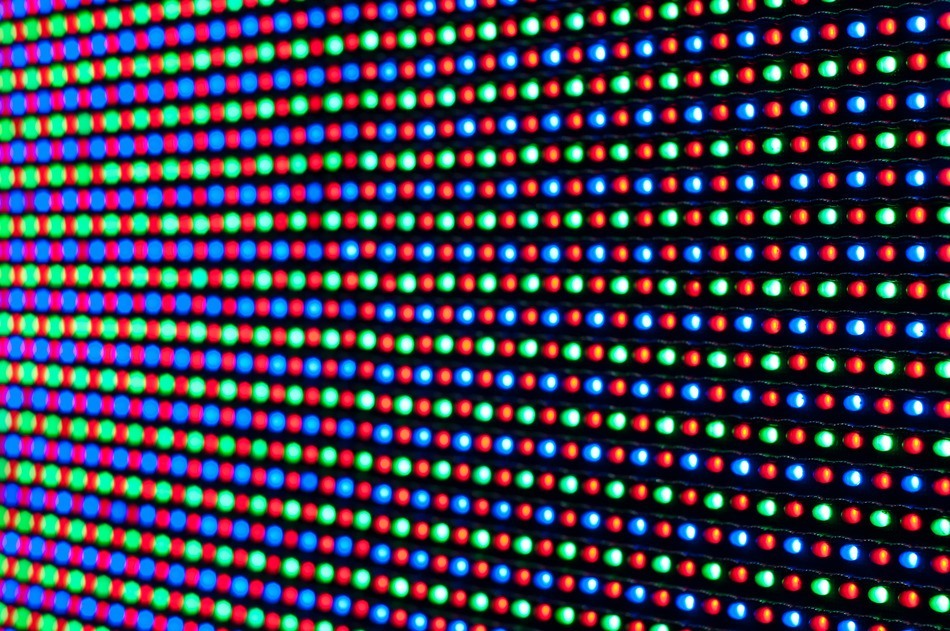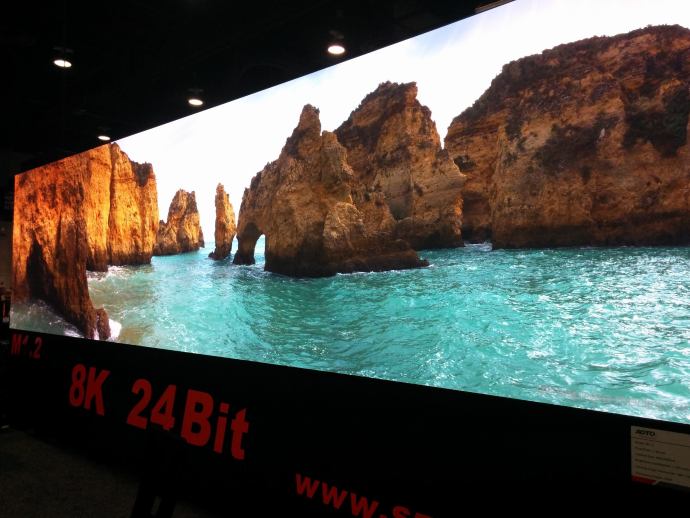
13 Options For Fine Pixel-Pitch Indoor LED Displays
November 23, 2015 by guest author, Curtis Tilly

You’re probably seen those big, bright digital billboards along a busy highway in your city, in a place like Times Square or in the form of those monster screens looming over the field at major sports stadiums. They look amazing … until you get up close. A few feet away they look anything but amazing.
That owes to the pixel pitch – the distance between the individual LED lights that make up these giant displays. When outside, that distance is 10 mm or more apart from one another. Up close, those dispersed pixels pull the image apart. At a distance, our eyes don’t see the gaps and the images look tight and crisp. The giant billboard that ate Times Square looks amazing up above the street, but it only has a pixzel pitch of 10 mm. If you got a ladder and got up close (without getting arrested), you’d see the LED diode gaps.
LED has been taking over from traditional static signage for years now, but it hasn’t really found its way inside businesses. But that’s changing. Fine pixel pitch LED displays are showing up in the digital signage marketplace with increasing frequency. Just a few years ago, an LED display with a 6 mm pixel pitch dropped jaws. Now, there are products with a 0.8 mm pixel pitch, with visuals that look crisp – even just a foot or two away.
The finer the pixel pitch, the more these units tend to cost. It’s like the display business in general. The latest and greatest always tends to cost the most. The highest resolution LED walls for indoor use can set you back as much as $25,000 – per square meter. That means that if you were interested in a billboard-sized indoor display, you’d be looking to spend around $500,000, or more.
That high cost owes to the number of LED clusters in the display. Atlanta-based NanoLumens has a good explanation. Its 114? display with a 4 mm pixel pitch uses 247,760 pixels, whereas a 6 mm LED display of the same size uses 96,000. The more LED clusters in your display, the company explains, the higher the cost.
So why go down that path? The answer is fairly straightforward.
- Seams? What Seams? – Because of the way they’re designed, LED modules have razor-thin gaps. This means that indoor video walls have none of the grid lines that are evident when the LCD modules are joined together in a typical configuration.
- Brightness Like You’ve Never Seen – LEDs push out much more light when you’re comparing them to typical professional LCD monitors. This can be absolutely critical in environments where there is a lot of light, like a shopping mall, the atrium in an office tower or more.

Active Vendors
Most of the early entries into the fine pixel pitch LED market were Chinese companies with little global brand recognition. They include companies like:
- Absen: Chinese, but with a strong US presence, Absen markets LEDs as fine as 4 mm, with super-thin modules that are easily serviced.
- Leyard Optoelectronic Co., Ltd: Based in Shenzhen, China, Leyard offers very fine pixel pitch 8K LED displays. The company also recently acquired the Portland, Oregon-based Planar, which should help extend its presence to a whole new market.
- Shenzhen AOTO Electronics: As the name suggests, this firm is also based in China’s tech hub, near Hong Kong. The company has LED modules that start at the super-fine pitch of .7 mm, and scale up from there. The size range in the ultra high def M series is M0.7, M1, M1.2, M1.5, M1.7, M2, M2.2, M2.5, M2.8, M3, M3.5, M4 and M4.8.
- Unilumin: Again from Shenzhen, Unilumin’s UTV series boasts ultra high density LED displays that start at 0.8mm and scale up from there, with 1.0mm, 1.2mm, 1.4mm to 1.6mm, 1.9mm and 2.5mm products. The company says it is doing R&D work on a 0.6 mm product.
Not all the companies come from Shenzhen …
- SiliconCore Technology: SiliconCore Technology has been making LED Displays and laser diode controls in California for almost two decades.The company gives its indoor displays floral names, with the flagship model, the Magnolia, a 1.5 mm that has over 444,000 pixels, or over 1,300,000 LED chips in just one square meter of display area. The company also has a 1.2 mm, and scales up to 5.5 mm.
- PixelFLEX: This Nashville LED manufacturer has FLEXUltra product line is now available in 1.6 mm, 1.9 mm, 1.9 mm front-serviceable, 2.5 mm and 2.57 mm curveable front-serviceable options. It’s unique offer is high resolution that still allows for the creation of either convex or concave video walls with custom designed frames.
Recently, a number of more familiar names have entered the very fine pixel pitch market:
- Barco: The Belgian company long known for high quality outdoor LED displays now has a series for indoor use, running from 1.6 to 2.7 mm. It also has a more conventional 5.5 mm LED tile, and its outdoor lines.
- Christie Digital: Based out of Cypress, California, they specialize in seamless indoor LED tiles with high resolutions that are inherently scalable for full design flexibility at 1.9mm, 2.5mm, 3.0mm and 4.0mm pixel pitches. Know for a long time as “just” a projector company, Christie has expanded over the last few years into display tiles, LCDs and very fine pixel pitch LEDs under the brand name “Velvet.”
- Daktronics: The dominant player in the sports stadium market has also branched into a line of indoor video displays, starting at 1.9 mm,
- NanoLumens: This Atlanta-area company is best known for flexible, thin, lightweight displays that can easily conform to curved surfaces and be suspended from ceilings without needing reinforcement. The company’s finest displays are 1.8 mm.
- NEC Display Solutions: The Japanese professional monitor company has recently started a marketing partnership that rolls LED products from the German firm S[Quadrat] under the NEC umbrella. The fine pixel pitch indoor LED displays start at 1.5 mm pixel pitch, and there are also 1.9, 2.3, and 3.8 mm versions.
- Panasonic: The Japanese electronics giant, know much more for Panasonic and then LCD displays, markets units with 1.9 mm, 2.5 mm, 3.0 mm and 4.0 mm pixel pitches.
- Planar: Based out of Beaverton, Oregon, Planar recently introduced a new line of seamless, very fine pixel pitch LED video walls, in partnership with Leyard, which later acquired Planar. The Planar DirectLight LED video walls are available in 1.6, 1.9, 2.5 and 3.1 mm pitches.
Sorting Out Distances
Quality, price, supply chain and support are all huge factors at play when choosing the right LED supplier. However, buyers also need to understand what the job really needs. There’s little point to paying a premium for a very fine pitch LED display if the viewing audience won’t typically get close enough to discern the difference.
Using a 1.9 mm pixel pitch wall, when viewers are all seeing the screen from many meters away, is largely a waste of money – with the saved budget far better spent on ensuring there’s always great content.
So how do you determine what to use? Here’s the industry’s rule of thumb: Christie suggests an easy way is to take the number from the pixel pitch, multiply that number (not the mm part) by 8 feet, and what you’re left with is the optimal viewing distance of the screen in question.
An LED display with a 1.9 mm pixel pitch will look fantastic from 15 or more feet away. If you get closer than that, people with very good eyesight will start to see the visuals degrade as they get closer, but even from a few feet away it looks pretty good.
A pixel pitch of 4 mm will look great from 30 feet or so. Any closer, and the same thing happens.
Daktronics has a useful guide on viewing distances at the bottom of this product page …
For jobs that have the audience in very close quarters, LCD video walls with super narrow bezels are still the best, and far more affordable option. But the people selling those LCD walls have an increasingly challenging competitor in indoor LED.



Leave a comment